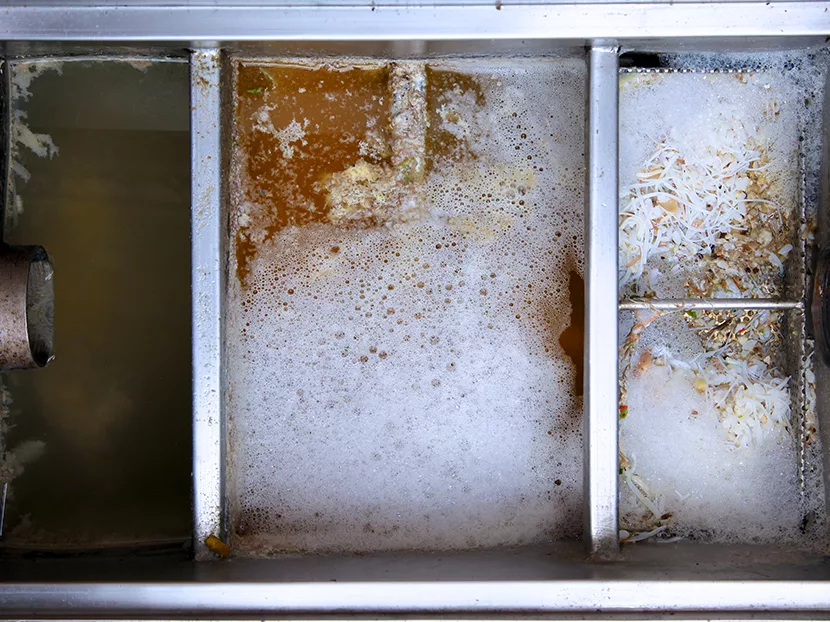In college I worked a number of odd jobs, one of which was at a little restaurant in a mall. I did several jobs in the restaurant’s kitchen, including cleaning out the grease trap under the three-compartment sink. If you have never had the opportunity, well you don’t know what you’re missing.
Kitchen grease waste is handled in a number of ways, one of which is an under-counter above-floor unit otherwise known as a grease trap. If you’ve ever cleaned out one of these beauties, you know exactly what you are not missing. These units range in size from 4 gpm to 100 gpm, or in other words, between 8 pounds and 100 pounds of grease waste capacity.
The smaller units come in a variety of designs, which range from a standard flow through (passive) unit (HGI) to a semi-automatic draw-off of grease, to a small grease recovery device (GRD). Granted, these are more commonly installed in small kitchens or installed on a specific piece of equipment, but they are applied in rare occasions on a health care project.
More commonly installed are the exterior 500- to 3,000-gallon grease interceptors. These larger grease interceptors require a pumping truck to suction the grease from the interceptor on a schedule, approximately every four to seven weeks. The odor is not pleasant and can linger in the area if not properly located.
Yes, odor is one of the key elements that plumbing designers consider, in addition to keeping grease suspended long enough to reach the grease interceptor. Once grease has made it to the interceptor, it needs time to cool and congeal, allowing it to rise to the top and drop out any solids to the bottom of the tank. Water then flows through to the sanitary system relatively grease-free.
The location of the grease interceptor outside is important due to the direction of prevailing winds. You do not want a grease interceptor’s odors to be directed back at the facility or even in an entrance to the building.
Whether or not to locate the grease interceptor outside is typically determined by where the kitchen is located within the building. The biggest challenge is getting the waste to the outside, while keeping the grease suspended long enough to make it to the interceptor.
For obvious logistical reasons, kitchens are located near loading docks. This allows food and supplies to enter and make their way to the kitchen storage areas without having to pass through public corridors.
Loading docks provide easy access for the pumping truck to come in (usually late at night) and clean out the interceptor. This location, in many cases, is wide open and perfect for allowing the wind to carry the odors away from the building.
When the perfect location simply is not available, where do you locate the interceptor?
An Automatic Grease Removal Device (AGRD) is an active system that has a skimmer that removes grease from kitchen wastewater. The active components are subject to the ASME A.1120.14.3 standards.
These systems include either a passive tank or a 50-gallon drum, which can store effluent for recycling and are subject to the same standards as HGIs. The grease-retention chambers on these units are simple enough to empty without special equipment.
The active component, which may include a skimmer or other device to remove grease from water, is activated manually by kitchen workers, or automatically based on electronic controls or a mechanical timer.
If you find yourself having to pipe grease waste from deep inside the building, consider the following:
- How far from the loading dock is the grease interceptor’s proposed location?
- Which way are the prevailing winds coming from?
- Will the grease interceptor be located in the loading dock? If so, how much lower is the pavement from the basement floor level?
- Will you heat-trace the grease waste line under slab?
- Will you consider pumping to barrels to be hauled off for recycling?
- How often does the facility want to clean the interceptor?
- Will the discharge side of the interceptor be high enough to meet the sanitary line in the street or will you have to pump it?
- You will need to know the kitchen cleaning procedures and chemicals used in this process.
- Consider implementing a grease interceptor temperature-monitoring system to monitor temperature spikes within the tank.
- Will the interceptor be located somewhere other than the loading dock?
- Which code will you be following and are there any local amendments to consider?
- Is there room inside the facility to house the AGRD?
- How will you get grease waste piping to the interceptor?
Nearly all municipalities require a pretreatment for most commercial kitchens, but specific requirements can vary from health department to health department. In other places, regulations may dictate what type of grease interceptor is permissible or how often it must be serviced. Regulations may also dictate how the unit is installed.
A phone call to your local wastewater authority or plumbing inspector can quickly help you understand your regulatory requirements. Your plumber, engineer or kitchen equipment consultant can also help.
Something else to consider installing on each grease interceptor you design going forward is a grease interceptor monitoring system.
The major advantage of the monitoring system is that it provides advance warning of problems and the need for service without a manual inspection. With continuous monitoring through a Building Automation System (BMS), the hospital and the city are able to identify problems even when the inspector is not present. The monitoring system gives the hospital and the city a powerful tool to prevent blockages and sanitary sewer overflows, and it provides documentation of regulatory compliance at a lower cost.
Additionally, the monitoring system makes it possible to keep track of interceptors that are not easily accessed or cannot be accessed during normal business hours.
The monitoring systems require minimal ongoing maintenance. When the grease interceptor monitoring system is installed for the first time, it needs to be calibrated. It is recommended that the pipe in which the transducer is mounted is flushed right after installation to eliminate any potential obstructions and objectionable water that were introduced during installation.
Between grease extractions, the monitoring system is designed to be maintenance-free. After the tanks are serviced, it is recommended to flush out the pipe and rinse the transducer.
The hospital's grease interceptor’s maintenance and service requirements are likely to be cut in half.
The monitoring solution is highly effective given the alternatives of manual inspection, sampling, pumping on a schedule and cleaning out the sewer line every three months. I have provided some of the benefits to the city and the hospital below.
Hospital
- Prevents backups
- Avoids costly fines
- Serves as verification that the interceptors have been correctly pumped and properly serviced
- Allows for continuous monitoring of the kitchen staff’s waste management practices for grease waste disposal
City
- Provides an early warning of issues that need corrective action
- Documents compliance, and prevents sanitary sewer overflows related to grease-laden material blockages
- The city can reduce manual inspections, reduce the frequency of sampling and reduce the cost of maintaining the sewer line
- The city staff can do more with less, which reduces the need to add additional staff
- Improved maintenance extends the life of the equipment and reduces the life cycle cost
As you can see, there are many benefits to incorporating a grease interceptor monitoring system, in addition to placement of the grease interceptor itself.
This approach allows for an odor-free area that visitors and staff alike can pass freely without the foul odor that can linger in the air around these pieces of equipment. This approach also provides a cost reduction to both the city and the facility in staffing and expenses for maintaining such systems.






